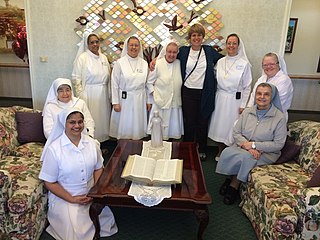
A hermit, also known as an eremite or solitary, is a person who lives in seclusion. Eremitism plays a role in a variety of religions.

The Apostolic Movement of Schoenstatt is a Catholic Marian movement founded in Germany in 1914 by Fr Joseph Kentenich, who saw the movement as a means of spiritual renewal for the Catholic Church. The movement is named after the small locality of Schönstatt which is part of the town of Vallendar near Koblenz, in Germany.

Catherine de Hueck Doherty was a Russian-born Catholic activist who founded the Madonna House Apostolate in 1947. She was a pioneer in the struggle for interracial justice, spiritual writer, lecturer, and spiritual mother to priests and laity.
Edward Doherty was an American newspaper reporter, author and Oscar-nominated screenwriter. Twice-widowed, he married once more to Catherine de Hueck Doherty, founder of the Madonna House Apostolate, and later was ordained a priest in the Melkite Greek Catholic Church.
Friendship House was a Catholic apostolate serving the poor, founded in Toronto in 1934 by Russian-born Catholic lay leader Catherine de Hueck Doherty. After its closure in 1936, de Hueck moved to Harlem, where others again joined her—living among the black community, responding to the needs they encountered, and challenging the racial discrimination of the times. The movement spread to Chicago and other American cities.

Combermere is a village along the Madawaska River in south-eastern Ontario, Canada. It is part of Township of Madawaska Valley. It is named after Sir Stapleton Cotton, Viscount Combermere (1773–1865).
Catholic spirituality includes the various ways in which Catholics live out their Baptismal promise through prayer and action. The primary prayer of all Catholics is the Eucharistic liturgy in which they celebrate and share their faith together, in accord with Jesus' instruction: "Do this in memory of me." The Catholic bishops at the Second Vatican Council decreed that "devotions should be so drawn up that they harmonize with the liturgical seasons, accord with the sacred liturgy, are in some fashion derived from it, and lead the people to it, since, in fact, the liturgy by its very nature far surpasses any of them." In accord with this, many additional forms of prayer have developed over the centuries as means of animating one's personal Christian life, at times in gatherings with others. Each of the religious orders and congregations of the Catholic church, as well as lay groupings, has specifics to its own spirituality – its way of approaching God in prayer to foster its way of living out the Gospel.
Joseph Raya was a Lebanese-born Melkite Catholic prelate who served as Archeparch of Akka from 1968 to 1974. He was also a theologian and civil rights advocate.
Ellen Tarry was an African-American journalist and author who served as a minor figure in the Harlem Renaissance. Her Janie Belle (1940) was the first African-American picture book, and her other works include further literature for children and young adults as well as an autobiography.

Sobornost is a Russian term whose usage is primarily attributed to the 19th-century Slavophile Russian writers Ivan Kireyevsky (1806–1856) and Aleksey Khomyakov (1804–1860). The term expresses the need for co-operation between people at the expense of individualism, on the basis that opposing groups focus on what is common between them. Khomyakov believed that the Western world was progressively losing its unity because it was embracing Aristotle and his defining individualism. Kireyevsky believed that G. W. F. Hegel and Aristotle represented the same ideal of unity.
A Catholic lay association, also referred to as Catholic Congress, is an association of lay Catholics aiming to discuss certain political or social issues from a Catholic perspective.

A hermitage most authentically refers to a place where a hermit lives in seclusion from the world, or a building or settlement where a person or a group of people lived religiously, in seclusion. Particularly as a name or part of the name of properties its meaning is often imprecise, harking to a distant period of local history, components of the building material, or recalling any former sanctuary or holy place. Secondary churches or establishments run from a monastery were often called "hermitages".
Madeleine Hutin, taking the name Little Sister Magdeleine of Jesus, founded a Roman Catholic community of religious sisters, the Little Sisters of Jesus, on 8 September 1939 in Touggourt, French Algeria. She was inspired by the life and writings of Charles de Foucauld.

The Religious Teachers Venerini, are a religious institute in the Catholic Church founded in Italy by Saint Rose Venerini in 1685. They were the pioneers of free public education for girls in Italy. They are commonly called the Venerini Sisters.

The Missionary of Jesus the Eternal Priest is a Roman Catholic religious order for women, founded by the Servant of God Mother Margherita Maria Guaini in May 1947, in Atella, Diocese of Melfi (Italy). The community moved to Varallo Sesia in the Province of Vercelli, where they were welcomed and supported by Mons. Gilla Vincenzo Gremigni, Bishop of Novara.

The Franciscan Hospitaller Sisters of the Immaculate Conception are members of a Roman Catholic religious institute of consecrated women, which was founded in Portugal in 1871. They follow the Rule of the Third Order Regular of St. Francis. and, as the term “hospitaller” indicates, focus their ministries on a spirit of medical care. Their charism emphasizes hospitality and service under the model of the Good Samaritan. In this congregation, the postnominal initials used after each sister's name is "F.H.I.C."

María Concepción of the Nativity and the Perpetual Help of Mary is the religious name of the Reverend Mother Foundress of The Order of Atonement of the Franciscan Minims of the Perpetual Help of Mary (mfPS) which she founded on June 24, 1942, in Zamora, Michoacan, Mexico.
The Russian Religious Renaissance was a period from roughly 1880 -1950 which witnessed a great creative outpouring of Russian philosophy, theology and spirituality. The term is derived from the title of a 1963 book by Nicholas Zernov called, The Russian Religious Renaissance of the Twentieth Century. The renaissance began in the late nineteenth century but was unexpectedly driven out of Russia due to the violent upheavals of the Bolshevik Revolution and early atheistic Communist regimes. This dislocation led to the resettlement of many Russian intelligentsia in Europe and the West where the renaissance reached its full expression. Although often viewed as a development within the Russian Orthodox world, the spiritual ideals of the Russian Religious Renaissance were carried throughout the wider Eastern Orthodox Church and even into the Roman Catholic and Protestant communities.
George Barry Ford was an American Roman Catholic priest, advocate of civil rights, and the chaplain who, along with Fr. Moore, led Thomas Merton to the Roman Catholic Church. He was twice silenced by Cardinal Francis Spellman, and was a close friend of Eleanor Roosevelt and Carlton J. H. Hayes. Dr. Henry P. Van Dusen, then president of Union Theological Seminary next to Corpus Christi, described Father Ford as "the best known and best loved man in the Morningside Heights community".
Francis Martin was an American Catholic priest of the Archdiocese of Washington, and a professor of Sacred Scripture. His teaching appointments included the Dominican House of Studies, the John Paul II Institute, the Catholic University of America, and Sacred Heart Major Seminary. Martin was an advisor to Cardinal Leo Joseph Suenens during the Second Vatican Council.












